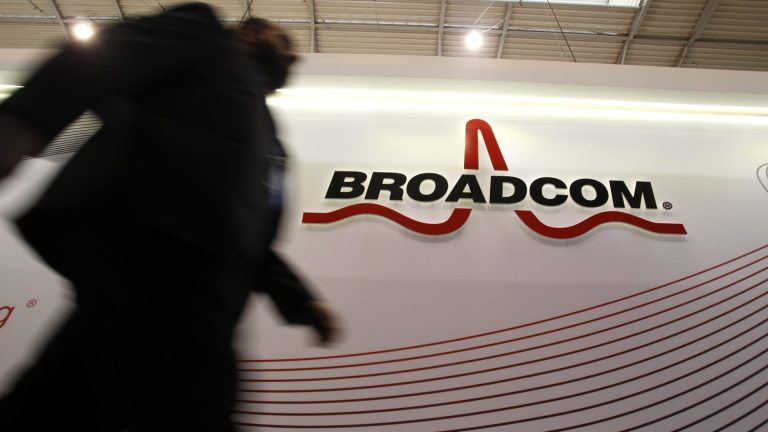When two Club tech firms – enterprise software giant Salesforce (CRM) and chipmaker Broadcom (AVGO) – report quarterly results this week, Wall Street will be looking to see if their respective bets on artificial intelligence are starting to pay off. Adoption of recently launched generative AI tools is part of the long-term investment story at Salesforce, which reports fiscal year 2024 second-quarter results after Wednesday’s close. Investors will be looking to see if the software company can sustain double-digit-percentage revenue growth, while also further boosting profitability. And when Broadcom releases its fiscal third-quarter earnings after the closing bell on Thursday, investors will be eyeing whether the semiconductor firm’s growing stream of AI-linked revenues are progressing at a pace to offset weakness in areas such as enterprise data centers and wireless. The earnings from Salesforce and Broadcom follow a rough patch for technology stocks that began in mid-July. From that point through the first half of August, the S & P 500 information technology sector dropped about 9% before rebounding slightly over the past two weeks. Broadcom entered Tuesday’s session down about 6.4% from its three-month closing high of $920 per share, on Aug. 1. Salesforce, on the other hand, is off 9.7% from its three-month closing high of $234.37, on July 19. Both stocks remain up more than 50% year-to-date. .SPX AVGO,CRM 3M mountain The S & P 500’s performance versus Broadcom and Salesforce over the past three months. Salesforce For the three months ended July 31, Wall Street expects Salesforce’s revenue to jump more than 10% year-over-year, to $8.53 billion, according to Refinitiv. Earnings-per-share (EPS) should come in at $1.90 for the quarter, compared with $1.19 a share a year prior. The deterioration in enterprise-software demand that began last year has appeared to stabilize, analysts say — albeit at lower levels than 18 to 24 months ago. But investors are still grappling with the top-line implications for Salesforce, according to Scott Berg, an analyst at Needham & Co. “The question I get most often from [investors] is: ‘Is this actually a 10% revenue growth story going forward, even once the macro [economic situation] recovers, or is this really maybe an 8% to 10% growth story?” Berg said in an interview with CNBC. “You view valuation very differently between those two realms,” he added. Over the next few quarters, the price hikes Salesforce implemented earlier this month could begin to show up in the company’s contract pipeline. In a note to clients last week, Wells Fargo suggested the price increases could add between 1% and 2% to Salesforce’s sales growth rate, helping it stay above that closely watched 10% level in the near term. Salesforce’s continued rollout of generative AI tools, which are becoming available to customers in phases , may take longer to meaningfully alter its revenue trajectory. Analysts widely expect any impact to show up starting in the company’s fiscal year 2025, which begins in February. At the same time, a debate over Salesforce’s profitability hinges on whether its margin expansion this year — amid an unprecedented activist-investor push — has any further room to run. Salesforce’s adjusted operating margin is expected to be 28.4% in its second quarter, according to FactSet, compared with roughly 20% during the same period last year. While some investors are skeptical Salesforce can continue to expand its margins given its history of overspending, Needham’s Berg argued that if the company is able to demonstrate it remains serious about cutting costs there could be a pool of investors willing to buy up the stock. Still, analysts say, a bigger inflection point for the stock will likely come next month, when Salesforce hosts its annual customer conference, known as Dreamforce , which is set to focus heavily on AI. Broadcom For the three months ended July 31, Wall Street expects revenue at Broadcom to increase nearly 5% year-over-year, to $8.86 billion, according to Refinitiv. Analysts predict EPS to rise by 7% on an annual basis, to $10.42 a share. Broadcom’s earnings release will put under the microscope the primary reason we added the company to the Club-stock ranks last week: its growing stream of generative AI-related revenues. In the company’s current fiscal year, AI-related revenues are expected to account for about 15% of the company’s semiconductor sales, and possibly grow to more than 25% in fiscal 2024, CEO Hock Tan said in June. Total semiconductor revenue is on pace to be about 80% of Broadcom’s overall revenue in fiscal 2023, which ends in October. Infrastructure software accounts for the remainder. Broadcom’s AI exposure currently falls into two primary buckets. The first is the firm’s work developing custom chips for hyperscalers, or tensor processing units, for Club holding Alphabet (GOOGL). The Google parent has been using TPUs for machine-learning work since 2016 , and has more recently stepped-up its efforts around its Bard chatbot and other AI initiatives. Google’s efforts are good news for Broadcom, KeyBanc analyst John Vinh told CNBC. “Obviously, what Google is doing with Bard…the expectation is [Broadcom is] going to see a pretty meaningful uplift there,” Vinh said in an interview, Broadcom’s other primary source of AI sales comes from its networking solutions. At a high level, these products efficiently stitch together multiple servers inside a data center, in order to meet the extensive performance requirements for AI workloads. Its two chips in this area are known as Tomahawk 5 and Jericho 3-AI. While Broadcom’s AI networking business is no doubt fast-growing, Vinh noted there are headwinds within other pockets of its wide-ranging semiconductor business, such as traditional enterprise networking and broadband. Still, Broadcom should at least deliver fiscal third-quarter results that meet Wall Street’s expectations, according to UBS. In a note to investors this week, the firm argued that Broadcom’s fiscal fourth-quarter guidance could be stronger than anticipated, “as the feeding frenzy from cloud customers helps to offset ongoing weakness in enterprise.” (Jim Cramer’s Charitable Trust is long CRM, AVGO, GOOGL. See here for a full list of the stocks.) As a subscriber to the CNBC Investing Club with Jim Cramer, you will receive a trade alert before Jim makes a trade. Jim waits 45 minutes after sending a trade alert before buying or selling a stock in his charitable trust’s portfolio. If Jim has talked about a stock on CNBC TV, he waits 72 hours after issuing the trade alert before executing the trade. THE ABOVE INVESTING CLUB INFORMATION IS SUBJECT TO OUR TERMS AND CONDITIONS AND PRIVACY POLICY , TOGETHER WITH OUR DISCLAIMER . NO FIDUCIARY OBLIGATION OR DUTY EXISTS, OR IS CREATED, BY VIRTUE OF YOUR RECEIPT OF ANY INFORMATION PROVIDED IN CONNECTION WITH THE INVESTING CLUB. NO SPECIFIC OUTCOME OR PROFIT IS GUARANTEED.
When two Club tech firms – enterprise software giant Salesforce (CRM) and chipmaker Broadcom (AVGO) – report quarterly results this week, Wall Street will be looking to see if their respective bets on artificial intelligence are starting to pay off.
Read the full article here









